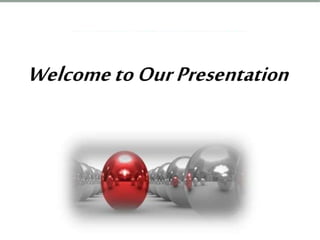
How Density can be a Property in Bioseparation....
- 2. Density : A Property for Bioseparation Group Members - Eilma Akhond Farjana Afroj Razib Datta Shubhra Nazmul Haque Rony
- 3. Bioseparation ??? Bioseparation refers to the systematic study of the scientific and engineering principles utilized for the large-scale purification of biological products. Actually it is largely based on chemical separation processes which is called multi-technique separation processes, i.e., two or more separation techniques are used for the separation of a single biological product. Density ??? Bioproduct ??? Bioproducts are the products originated from living organism. Bioproducts show some unique properties, such as- size, density, diffusivity, shape, polarity, solubility, electrostatic charge, volatility, thermal stability, isoelectric pH etc. These properties are the Physico-chemical basis of separation in bioseparation processes. The density of a substance is its mass per unit volume. The symbol most often used for density is ρ or, D. Mathematically, The mass of atoms, their size, and how they are arranged determine the density of a substance.
- 4. How ??? Density is a property in Bioseparation Density is a characteristic property of a substance. That is why it can be a property in bioseparation, such as, for the solution containing different densed particles, when gravity is the sole method for separation, density becomes a fundamental property in bioseparation processes. In a solution, under Gravity or centrifugal force, whose density is higher than that of the solvent sink and particles that is lighter than that float on the top. The greater the difference in density, the faster they move. If there is no difference in density (isopyknic conditions), the particles stay steady. Fig: Schematic diagram of different densed particles moving at different region in a solution during a separation process (centrifugation).
- 5. Bioseparation Processes The particles having density differences can be separated from each other by applying external forces. According to this principle, some bioseparation processes are used for the separation of density based bioproducts. These are- 1. Centrifugation 2. Sedimentation 3. Flotation
- 6. Centrifugation • Centrifugation is a process which separates particles from a solution according to their size, shape, density, viscosity of the medium and rotor speed. • When the mixture is introduced at a location within a liquid medium which is then subjected to an artificially induced gravitational field, this process utilizes density difference between the particles/macromolecules and the medium. • It is used in particle-particle separation in liquid medium. For example- the fractionation of sub-cellular organelle, the separation of plasmid DNA from chromosomal DNA, and the separation of mature cells from young cells.
- 7. When cells or tissues are homogenized by suspending them in an isotonic sucrose solution, plasma membrane is ruptured but the other organelles will remain intact. These components have different size and densities. So when different centrifugation forces are applied, we get different particles in supernatant and pellet. Differential centrifugation of sub-cellular component
- 8. Sedimentation • Sedimentation is the process of letting suspended material settled by gravity which is a natural force. Other forces may also perform in sedimentation, such as, centrifugal acceleration or electromagnetism. • Sedimentation is continuously used in the bioseparation process to separate biological molecules on the basis of buyoant densities. This process are also able to provide details on the purity of biological samples and information on molecular weights quite accurately. In sedimentation, the particles which are denser than the liquid medium would settle and form a zone with very high particulate concentration. This is referred to as the sediment and the clear liquid left behind is referred to as the supernatant. This has been shown in the flanking figure.
- 9. Equilibrium sedimentation • Equilibrium sedimentation is a typical sedimentation process. • It uses a gradient of a solution such as Caesium Chloride or Sucrose to separate particles (proteins, nucleic acids,other macromolecules etc.) based on their individual densities (isopycnic solution) and analyze molecules concentrated as bands where the molecule density matches that of the surrounding solution. • It is also known as a purifying process for differential centrifugation. Fig: A schematic diagram of equilibrium sedimentation
- 10. Flotation • Flotation is the process of separation of the particles according to their relative capacity for floating on a given liquid. This process is used in particle-liquid separation process. • This principle, utilized in floatation, is based on hydrophobicity differences. The increase in hydrophobicity, the decrease in density. So the hydrophobic particles become lighter than the liquid and other hydrophilic particles. Then the hydrophobic particles would tend to float and hence concentrate near the top of the container in which the suspension is held. • Industrially, floatation is used in the separation of the particles of a mass of crude ore. This process is also used in mining, waste water treatment and paper recycling.
- 11. Froth Floatation Process • In mineral treatment and mining, froth flotation is used as a process for separating minerals from crude ore by taking advantage of differences in their hydrophobicity. Most kinds of minerals require coating with a water repellent (surfactants) to make them float. This increases hydrophobicity differences. • By coating the minerals with small amounts of chemicals or oils, particles of the minerals remain unwetted and will thus adhere to air bubbles. • These hydrophobic materials take place in forth.
- 12. Thank You